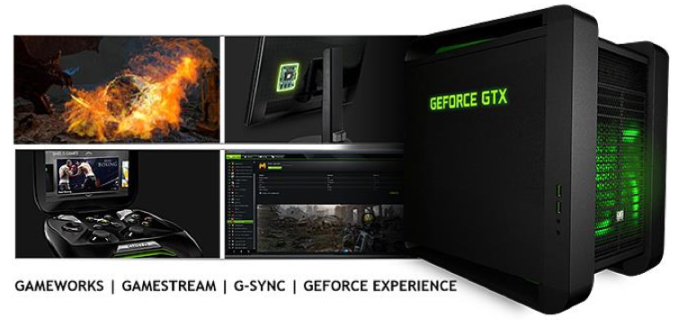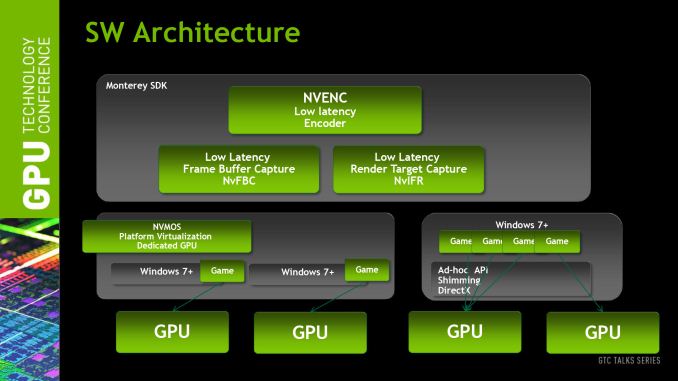The NVIDIA GeForce GTX 750 Ti and GTX 750 Review: Maxwell Makes Its Move
by Ryan Smith & Ganesh T S on February 18, 2014 9:00 AM ESTMaxwell’s Feature Set: Kepler Refined
To start our look at the Maxwell architecture, we’ll start with a look at the feature set, as this will be the shorter and easier subject to begin with.
In short, Maxwell only offers a handful of new features compared to Kepler. Kepler itself was a natural evolution of Fermi, further building on NVIDIA’s SM design and Direct3D 11 functionality. Maxwell in turn is a smaller evolution yet.
From a graphics/gaming perspective there will not be any changes. Maxwell remains a Direct3D 11.0 compliant design, supporting the base 11.0 functionality along with many (but not all) of the features required for Direct3D 11.1 and 11.2. NVIDIA as a whole has not professed much of an interest in being 11.1/11.2 compliant – they weren’t in a rush on 10.1 either – so this didn’t come as a great surprise to us. Nevertheless it is unfortunate, as NVIDIA carries enough market share that their support (or lack thereof) for a feature is often the deciding factor whether it’s used. Developers can still use cap bits to access the individual features of D3D 11.1/11.2 that Maxwell does support, but we will not be seeing 11.1 or 11.2 becoming a baseline for PC gaming hardware this year.
On the other hand this means that for the purposes of the GeForce family the GTX 750 series will fit in nicely into the current stack, despite the architectural differences. As a consumer perspective is still analogous to a graphics perspective, Maxwell does not have any features that will explicitly set it apart from Kepler. All 700 series parts will support the same features, even NVIDIA ecosystem features such as GameWorks, NVENC, and G-Sync, so Maxwell is fully aligned with Kepler in that respect.
At a lower level the feature set has only changed to a slightly greater degree. I/O functionality is identical to Kepler, with 4 display controllers backing NVIDIA’s capabilities. HDMI 1.4 and DisplayPort 1.2 functionality join the usual DVI support, with Maxwell being a bit early to support any next generation display connectivity standards.
Video Encode & Decode
Meanwhile turning our gaze towards video encoding and decoding, we find one of the few areas that has received a feature upgrade on Maxwell. NVENC, NVIDIA’s video encoder, has received an explicit performance boost. NVIDIA tells us that Maxwell’s NVENC should be 1.5x-2x faster than Kepler’s NVENC, or in absolute terms capable of encoding speeds 6x-8x faster than real time.
For the purposes of the GTX 750 series, the impact of this upgrade will heavy depend on how NVENC is being leveraged. For real time applications such as ShadowPlay and GameStream, which by the very definition can’t operate faster than real time, the benefit will primarily be a reduction in encoding latency by upwards of several milliseconds. For offline video transcoding using utilities such as Cyberlink’s MediaEspresso, the greater throughput should directly translate into faster transcoding.
The bigger impact of this will be felt in mobile and server applications, when GM107 makes its introduction in those product lines. In the case of mobile usage the greater performance of Maxwell’s NVENC block directly corresponds with lower power usage, which will reduce the energy costs of using it when operating off of a battery. Meanwhile in server applications the greater performance will allow a sliding scale of latency reductions and an increase in the number of client sessions being streamed off of a single GPU, which for NVIDIA’s purposes means they will get to increase the client density of their GRID products.
Speaking of video, decoding is also receiving a bit of a lift. Maxwell’s VP video decode block won’t feature full H.265 (HEVC) support, but NVIDIA is telling us that they will offer partial hardware acceleration, relying on a mix of software and hardware to decode H.265. We had been hoping for full hardware support on Maxwell, but it looks like it’s a bit premature for that in a discrete GPU. The downside to this is that the long upgrade cycle for video cards – many users are averaging 4 years these days – means there’s a good chance that GTX 750 owners will still be on their GTX 750 cards when H.265 content starts arriving in force, so it will be interesting to see just how much of the process NVIDIA can offload onto their hardware as it stands.
H.265 aside, video decoding overall is getting faster and lower power. NVIDIA tells us that decoding is getting a 8x-10x performance boost due to the implementation of a local decoder cache and an increase in memory efficiency for video decoding. As for power consumption, combined with the aforementioned performance gains, NVIDIA has implemented a new power state called “GC5” specifically for low usage tasks such as video playback. Unfortunately NVIDIA isn’t telling us much about how GC5 works, but as we’ll see in our benchmarks there is a small but distinct improvement in power consumption in the video decode process.












177 Comments
View All Comments
EdgeOfDetroit - Tuesday, February 18, 2014 - link
The EVGAs have Displayport, but they might be the only ones. I ordered the Superclocked 750 Ti with the $5 rebate from Newegg because it had a DisplayPort and the competitors did not.Death666Angel - Tuesday, February 18, 2014 - link
"the 760 has been out for almost a year now and is an older process" -> Still the same 28nm process for the 760 and 750 alike. :)MrPoletski - Tuesday, February 18, 2014 - link
This jump in cache for 128k to 2mb... I wonder what that does for cryptocurrency mining?The Von Matrices - Tuesday, February 18, 2014 - link
Unless the integer shift operation has been improved, not much.g101 - Tuesday, February 18, 2014 - link
Nothing, nividia is fundamentally deficient with integer compute, these are architectural decisions that NVidia made in hopes of squeezing out slightly better FPS. Think: anti-gpgpu, or more of a classic asic.So no, this arc isn't going to change their position with regards to the actual algorithms. Perhaps there will be a moderate increase in sCrypt sha2 performance (due to the memory-hard nature of that implementation), however, nvidia's extreme (and sometimes intentional) incompetence with gpgpu leads me to believe that they still do not understand that GPGPU is the reason AMD's cards are above MSRP. It's not due to one specific hashing function, it's due to their superiority in over 11 specific functions, superior general opencl performance and comparatively greater performance for many SP compute intensive CUDA applications. For instance, cross-comparison between cuda and opencl raycasting yields some very interesting results, with the opencl/AMD solutions outperforming cuda 2:1, often with greater accuracy.
CUDA is easy, NVidia has zero compute advantage beyond 'ease'.
oleguy682 - Tuesday, February 18, 2014 - link
AMD receives nothing for their cards being sold over MSRP. Their channel partners likely have agreements in place for this generation of processors that is locked in at a specific price or price range. Perhaps if they signed new partners, or revised their processors substantially enough to warrant a new agreement, they can take advantage of the higher-than-MSRP situation, but I doubt it. And even the ASUS and Gigabytes of the world are likely unable to capitalize much on the demand. At best, they are able to sell boards to retailers as fast as they come off the line.Only the Neweggs are profiting handsomely off of this.
HighTech4US - Wednesday, February 19, 2014 - link
Von and g101 you are both wrong as Maxwell has now greatly improved integer compute. Check out the following review page from Tom's:http://www.tomshardware.com/reviews/geforce-gtx-75...
Quote: Historically, Nvidia's cards came up short against competing Radeons, which is why you see R9 290X boards selling for $700 and up. But the Maxwell architecture's improvements allow the 60 W GeForce GTX 750 Ti to outperform the 140 W GeForce GTX 660 and approach AMD's 150 W Radeon R7 265, which just launched, still isn't available yet, but is expected to sell for the same $150. On a scale of performance (in kH/s) per watt, that puts Nvidia way out ahead of AMD. Today, four GM107-based cards in a mining rig should be able to outperform a Radeon R9 290X for less money, using less power.
Yojimbo - Wednesday, February 19, 2014 - link
Which is good for NVidia, maybe just lucky. Increasing gamer market share in exchange for some short-term profits is probably a good trade-off for Nvidia. If AMD can't maintain their market share, they'll have less muscle behind their Mantle initiative.hpvd - Tuesday, February 18, 2014 - link
Does this first small Maxwell brings Support for Unified Virtual Memory Management IN HARDWARE? If yes: would be really interesting to see how efficient it could work...details see:
http://www.anandtech.com/show/7515/nvidia-announce...
willis936 - Tuesday, February 18, 2014 - link
I would like very much to see a comparison of GM107 in SLI to other $300 graphics card options. Us 560 Ti owners are in a tough position because it's upgradin' time and there's no decent, quiet solution. SLI is still a bit of a hack and from what I can tell can be more of a compatibility headache than a performance gain. These cards may be the exception though.